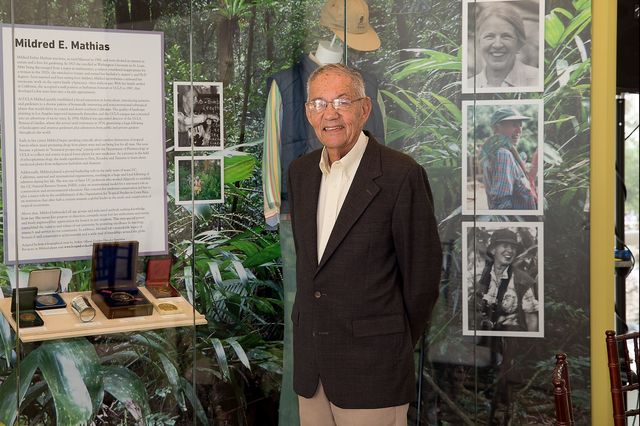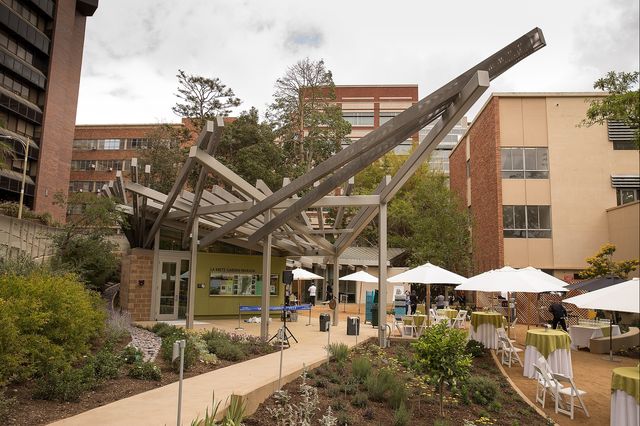UCLA’s Mildred E. Mathias Botanical Garden, a seven-and-a-half acre oasis of biodiversity housing more than 3,000 plant species, is undergoing the largest, most comprehensive upgrade in its history.
“We will preserve and improve this special garden for future generations so that people can reconnect with nature and plants,” said Victoria Sork, dean of life sciences in the UCLA College. “Chancellor Gene Block is committed to achieving this, and we intend to raise $25 million over a decade to do so. Many people don’t even know this treasure exists, but it’s free and open to everyone. While visitors enjoy the garden’s beauty, they can also learn about ecosystems, biodiversity and conservation.”
Among the garden’s offerings are collections of tropical and subtropical trees, Australian plants, conifers and Hawaiian plant species.
The front door to the garden is the new, $5 million La Kretz Garden Pavilion, which houses a new welcome center for visitors with space for classrooms, meetings and cultural events. The pavilion is the first phase in a series of renovations to increase the garden’s visibility, upgrade its infrastructure (including improving the trails and adding an irrigation system) and make it a focal point for visitors to UCLA. The public can view the garden pavilion and gardens at an open house Sept. 26, starting at noon, with docent tours at 1 p.m., 2 p.m. and 3 p.m. (reservations are not required).
Additional upgrades will include expanding collections of plants from California, Baja California and the Channel Islands, as well as species that increase the diversity of specimens. UCLA is also planning a redesigned informal patio with a fountain, improved pathways, an additional new Westwood entrance and a redesign and renovation of the garden’s 200-foot stream, which is home to turtles and koi.

Philip Rundel, a UCLA distinguished professor of ecology and evolutionary biology who holds a joint appointment in the UCLA Institute of the Environment and Sustainability, has called the garden “a special oasis of tranquility” for visitors, including students, faculty, staff and the public.
“When I give tours, everybody is amazed by the beauty of the garden,” said Rundel, who is the director of the botanical garden. “They can’t believe they are in West L.A.”
Sork praised the “beautiful building and creative design work” of Michael Lehrer, president of award-winning Lehrer Architects, and Roberto Sheinberg, the firm’s director of design, who are leading the garden’s revitalization project. They are working on the garden’s revitalization project in partnership with Mia Lehrer + Associates and UCLA Life Sciences.
“This magnificent UCLA garden is an outdoor laboratory for science courses, a special learning destination for Los Angeles schools from elementary through high school and a venue for a wide range of events,” Sork said. “The garden is a cherished part of our community, but has been desperately in need of improved infrastructure and maintenance. The generosity of Morton La Kretz is catalyzing this initiative to improve the infrastructure and reconceptualize the collection of gardens within the botanical garden to highlight the special collections.
“This gem is getting the renovation it has needed,” Sork added, “and the entire community is richer for it.”
The garden also contains a curved, shaded amphitheater called the Nest that hosts classes, plays, poetry readings, concerts and other events. Rundel has recently expanded the activities of this facility and plans to upgrade its size, seating quality and acoustics.
In explaining his generosity to the garden, La Kretz — a UCLA alumnus, philanthropist and environmental champion — spoke of the importance of conservation, plant diversity and protecting the environment for future generations, and called the garden a “great asset.”

La Kretz said at a 2014 celebration announcing the garden’s new entrance that he has clear memories of taking water samples from the garden’s stream and taking a group trip to Costa Rica escorted by Mildred Mathias, who was a professor of botany and director of the garden from 1956 until her retirement in 1974.
“Mildred was a pioneer who loved inspiring and educating people about plants, nature and conservation,” Sork said.
Created in 1929 — the year UCLA moved to Westwood — the garden, which is also used for research by UCLA scientists, includes many plants that cannot be found anywhere else in California.
Watch this video of the garden.
Located west of Hilgard Avenue and east of Tiverton Avenue, just south of Parking Structure 2 (map), the botanical garden is open Monday through Friday, from 8 a.m. to 5 p.m., and Saturday and Sunday, from 8 a.m. to 4 p.m. It is closed on university holidays. Admission is free.
For information about supporting the Mildred E. Mathias Botanical Garden, contact Ellen Beck in UCLA’s Life Sciences development office at 310-206- 6383 or ebeck@support.ucla.edu.





